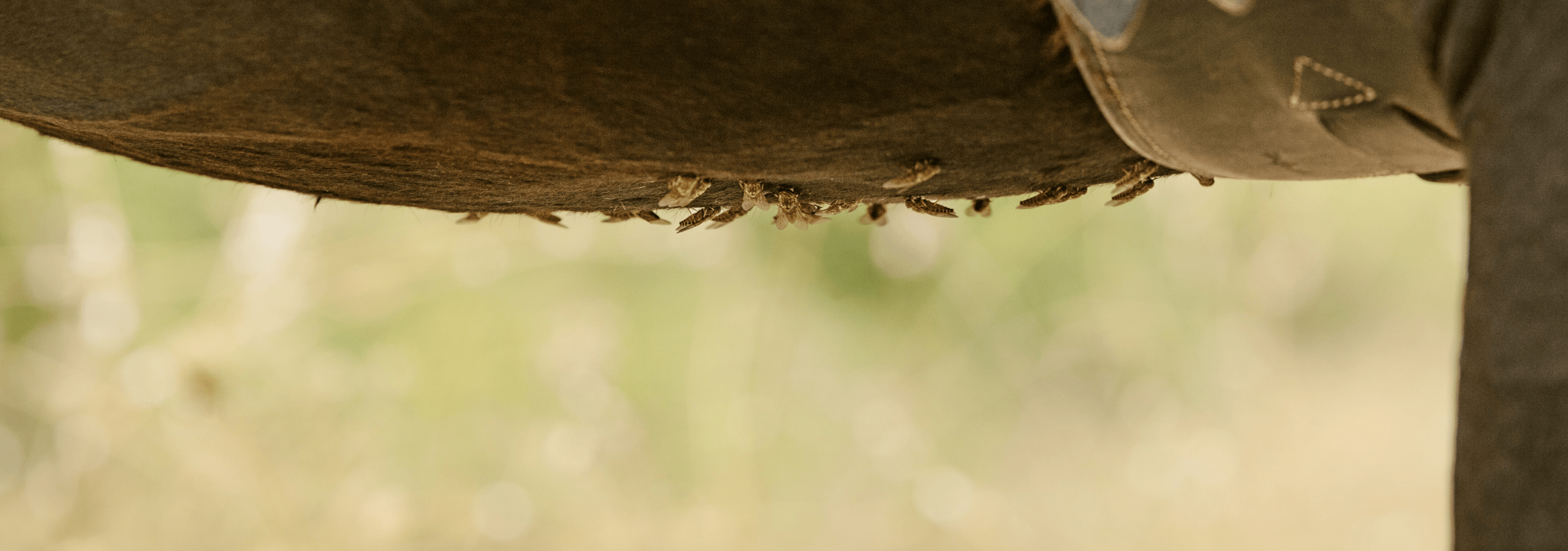
How to get rid of louse flies?
Sunny days are back and the louse flies are taking over? Do they make your life miserable?
How to keep louse flies away from your horse?
Every year it's the same story: as soon as the warm weather returns, the louse flies appear by dozens and invade the barns. They climb everywhere and settle where the horse can't chase them away.
How to tell if it's a louse fly ?
The louse fly, also known as keds depending on the region you're coming from, is an extremely resilient haematophagous (blood-feeding) parasite. It is mainly found around livestock such as cows, sheep and horses but also attacks birds and sometimes humans.
The louse fly is a member of the hippoboscidae family and the one that harasses our horses has the very self-explanatory name of hippobosca equina. Here's how to recognise it:
- the louse fly has a flat, hard body, with the head sunken into the thorax
- it is medium in size (5 to 8 millimeters),
- it has six stout legs with claws
- it moves laterally "crab-like" or by very short flight.
You can't go wrong! The louse fly is unlike any other.

It is said that knowing your enemy is a battle half won!
How do louse flies live?
The louse flies live almost exclusively on their host. They prefer to stay in areas where the skin is thin and where they are protected such as the inner thighs, the sheath or udder and the anal region. As they have very small wings, their ability to fly is limited. Therefore, louse flies move around the host using their clawed legs, or by very short flights (which are more like hopping).
What does the louse feed on?
The louse fly feeds on blood. It is said to be a haematophagous. Unlike other insects such as the mosquito, in which only the female bites, in louse flies, bites are caused by both males and females!
It is this bite that is very painful and causes the horse to make sudden defensive movements or show anxiety. Moreover, as the louse fly bites mainly in places that are inaccessible to them, horses quickly tend to reach such levels of frustration and discomfort that they can sometimes become dangerous. Pawing, rearing, kicking, displaying hyper-vigilant or even aggressive attitudes, it's all there and it's all the fault of the louse fly!

The louse fly and the horse
Louse flies are active from April to October with maximum activity in the summer. They give our horses a hard time, leaving them no respite, as they very rarely leave their host.
Direct nuisance:
The main nuisance associated with louse flies is obvious: it is harassment.
We've been talking about this since the beginning of this article. The fact that they constantly attack the horse without giving it a chance to defend itself, combined with the blood spoliation causes physical and psychological exhaustion.
Reduced feed intake, weight loss, skin lesions, stress... are all signs that the louse fly infestation is starting to take a serious toll on your horse's morale.
Indirect Nuisances:
At the moment, there are no scientific studies proving that the louse fly is a vector of equine pathologies. That said, its proliferation still raises questions about the transmission of diseases such as equine infectious anaemia, leptospirosis or anthrax and skin and intestinal parasites such as nematodes (Habronema microstoma) and helminths (Dermatobia hominis)
How to (finally!) get rid of louse flies
To date, there is no such thing as a real louse fly repellent. The best-known method is to literally decapitate every louse fly you can catch one by one. But if, like us, you're a little put off by this idea, there's another way to avoid bites!
All you need to do is apply a persistent, breathable ointment to all sensitive areas. For this, we recommend Natjely™ the 100% plant-based balm from Animaderm:
- Breathable, it does not smother the skin.
- Hydrating, it allows the epidermis to fight against external aggressions.
- Greasy, it wonderfully fulfills its role as a flat fly shield.
- Waterproof, it only requires an application every two to three days
- Non-photosensitizing, you can use it all summer long!
Its protective micro-film helps prevent biting (the louse flies crunch into...the balm!) and displacement (it slips!).
Bonus point: pheromones. This is a bit like the Messenger of insects. When one of them identifies a danger, it transmits the information to the other individuals of its species via pheromones, and tells them to avoid that danger, thus reducing the number of attacks considerably!
So, ready to give your horse a peaceful summer?
Information for guidance only - Not a substitute for a vet consultation
 ANIMADERM S.A.S
ANIMADERM S.A.S